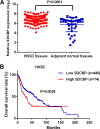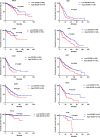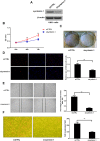Syntenin-1 is a promoter and prognostic marker of head and neck squamous cell carcinoma invasion and metastasis
- PMID: 27811365
- PMCID: PMC5347720
- DOI: 10.18632/oncotarget.13020
Syntenin-1 is a promoter and prognostic marker of head and neck squamous cell carcinoma invasion and metastasis
Abstract
Metastasis represents a key factor associated with poor prognosis of head and neck squamous cell carcinoma (HNSC). However, the underlying molecular mechanisms remain largely unknown. In this study, our liquid chromatography with tandem mass spectrometry analysis revealed a number of significantly differentially expressed membrane/membrane-associated proteins between high invasive UM1 and low invasive UM2 cells. One of the identified membrane proteins, Syntenin-1, was remarkably up-regulated in HNSC tissues and cell lines when compared to the controls, and also over-expressed in recurrent HNSC and high invasive UM1 cells. Syntenin-1 over-expression was found to be significantly associated with lymph node metastasis and disease recurrence. HNSC patients with higher syntenin-1 expression had significantly poorer long term overall survival and similar results were found in many other types of cancers based on analysis of The Cancer Genome Atlas data. Finally, knockdown of syntenin-1 inhibited the proliferation, migration and invasion of HNSC cells, and opposite findings were observed when syntenin-1 was over-expressed. Collectively, our studies indicate that syntenin-1 promotes invasion and progression of HNSC. It may serve as a valuable biomarker for lymph node metastasis or a potential target for therapeutic intervention in HNSC.
Keywords: head and neck squamous cell carcinoma; membrane proteins; metastasis; syntenin-1.
Conflict of interest statement
We declare no conflicts of interest.
Figures







References
-
- Siegel R, Ward E, Brawley O, Jemal A. Cancer statistics, 2011: the impact of eliminating socioeconomic and racial disparities on premature cancer deaths. CA Cancer J Clin. 2011;61:212–236. - PubMed
-
- Warnakulasuriya S. Global epidemiology of oral and oropharyngeal cancer. Oral Oncol. 2009;45:309–316. - PubMed
-
- Forastiere A, Koch W, Trotti A, Sidransky D. Head and neck cancer. N Engl J Med. 2001;345:1890–1900. - PubMed
-
- Noguti J, De Moura CF, De Jesus GP, Da Silva VH, Hossaka TA, Oshima CT, Ribeiro DA. Metastasis from oral cancer: an overview. Cancer Genomics Proteomics. 2012;9:329–335. - PubMed
Publication types
MeSH terms
Substances
Grants and funding
LinkOut - more resources
Full Text Sources
Other Literature Sources
Medical

